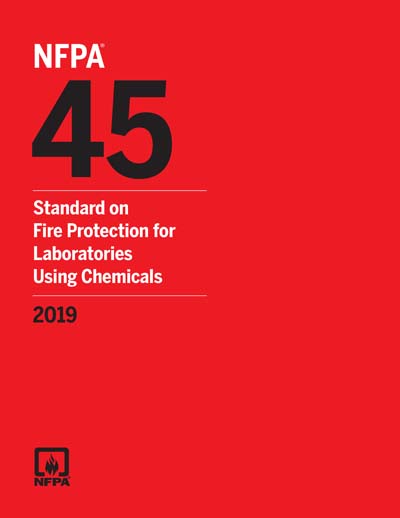Most recent
NFPA 45-2019
NFPA 45 Standard on Fire Protection for Laboratories Using Chemicals, 2019 edition
This standard shall apply to laboratory buildings, laboratory units, and laboratory work areas whether located above or below grade in which chemicals, as defined in NFPA 704 with one or more of the following hazard ratings are handled or stored: health — 2, 3, or 4; flammability — 2, 3, or 4; or instability — 2, 3, or 4. (See also Section B.2.) This standard shall apply to all educational laboratory units and instructional laboratory units in which any quantity of chemicals, as defined in NFPA 704 with one or more of the following hazard ratings, is handled or stored: health — 2, 3, or 4; flammability — 2, 3, or 4; or instability — 2, 3, or 4. (See also Section B.2.) With the exception of 1.1.2, this standard shall not apply to the following: (1)* Laboratories for which the following conditions apply: (a) Laboratory units that contain less than or equal to 4 L (1 gal) of flammable or combustible liquid (b) Laboratory units that contain less than 2.2 standard m3 (75 scf) of flammable gas, not including piped-in low-pressure utility gas installed in accordance with NFPA 54 (2)* Pilot plants (3) Laboratories that handle only chemicals with a hazard rating of 0 or 1 for all of the following: health, flammability, and instability, as defined by NFPA 704 (4) Laboratories that are primarily manufacturing plants (5) Incidental testing facilities (6) Physical, electronic, instrument, laser, or similar laboratories that use chemicals only for incidental purposes, such as cleaning (7)* Hazards associated with radioactive materials, as covered by NFPA 801 (8) Laboratories that work only with explosive material, as covered by NFPA 495 (9)* A laboratory work area containing an explosion hazard great enough to cause property damage outside that laboratory work area or injury outside that laboratory work area requiring medical treatment beyond first aid A laboratory work area contains an explosion hazard if an explosion of quantities or concentrations of reactive materials could result in serious or fatal injuries to personnel within that laboratory work area. Quantities or concentrations that pose an explosion hazard include, but are not limited to, the following: (1) Storage of more than 0.45 kg (1 lb) of materials with an instability hazard rating of 4 (see Table B.2.5) (2) Use or formation of more than 0.11 kg (0.25 lb) of materials with an instability hazard rating of 4 (see Table B.2.5) (3)* Presence of highly exothermic reactions in glass or open reaction vessels involving more than 10 g (0.35 oz) of materials such as polymerizations, oxidations, nitrations, peroxidations, hydrogenations, or organo-metallic reactions (4) Use or formation in glass or open reaction vessels involving more than 10 g (0.35 oz) of materials whose chemical structures indicate a potential hazard, but whose properties have not been established, such as salts of alkenes, triple bonds, epoxy radicals, nitro and nitroso compounds, and peroxides (5) Other explosion hazards as determined by a qualified person In such cases where a laboratory work area contains an explosion hazard, NFPA 45, supplemented by appropriate shielding, handling, and similar protective measures, does apply. A laboratory work area contains an explosion hazard if an explosion of quantities or concentrations of flammable gases or vapors or other explosion hazards as determined by a qualified person could result in serious or fatal injuries to personnel within that laboratory work area — in which case, NFPA 45 shall apply.
Content Provider
National Fire Protection Association [nfpa]






